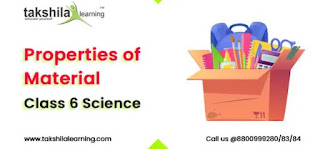Class 6 Science Properties of Material
Objects can be distinguished based on their characteristics, such as their shapes, qualities, and materials. Studies are more convenient when things are grouped based on their characteristics. It may be categorised according to similarities or differences.
The following are typical characteristics that are used to group the objects:
1) Lustre - Materials can be categorised according to how shiny or dull they are. Materials with lustre are shiny, while those without lustre are drab. For instance, shiny materials include things like gold, silver, etc., while non-shiny materials include things like wood, plastic, etc.
2) Hardness/Softness - Materials that are soft are more likely to be crushed or scratched. Cotton is a prime example. Hard materials like iron are among those that are difficult to compress.
3 Transparency
a) Transparent materials, or those that totally let the passage of light You can look right through them like glass.
b) Opaque materials, which are those that fully block out light. They are opaque, unlike cardboard, wood, etc.
c) Materials that are translucent allow some light to pass through them. Like frosted glass, it is partially transparent and opaque.
4) State: Matter exists in three states and is made up of objects.
-
a) Solid state: Solid states are a property of all solids. Solids have a distinct volume and shape. These substances cannot be compacted. Solids cannot flow because the particles are too closely packed.
b) Liquid state: Every substance that is liquid has a liquid state. Although liquids can adopt the shape of the container, they do not have a fixed shape. There is a clear loudness to it. Such materials are capable of some compression.
A gaseous state exists for all gaseous substances. Such a material lacks a clear volume and shape. They have tightly packed particles and are very compressible.
5) Soluble vs. Insoluble
Lemon juice, vinegar, and other soluble substances all create a single layer of water in water and are totally soluble in it.
Insoluble compounds, such as mustard oil, kerosene, etc., are not soluble in water and create the recognisable layer with it.
Read more

Comments
Post a Comment
Thank you we will contact ASAP.